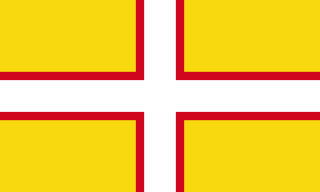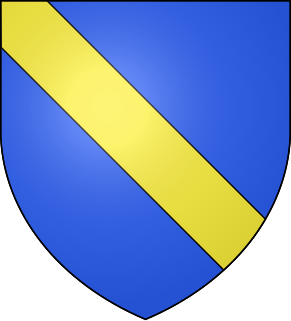
Heraldry is a discipline relating to the design, display and study of armorial bearings, as well as related disciplines, such as vexillology, together with the study of ceremony, rank and pedigree. Armory, the best-known branch of heraldry, concerns the design and transmission of the heraldic achievement. The achievement, or armorial bearings usually includes a coat of arms on a shield, helmet and crest, together with any accompanying devices, such as supporters, badges, heraldic banners and mottoes.

Dorset is a county in South West England on the English Channel coast. The ceremonial county comprises the unitary authority areas of Bournemouth, Christchurch and Poole and Dorset. Covering an area of 2,653 square kilometres (1,024 sq mi), Dorset borders Devon to the west, Somerset to the north-west, Wiltshire to the north-east, and Hampshire to the east. The county town is Dorchester, in the south. After the reorganisation of local government in 1974, the county border was extended eastward to incorporate the Hampshire towns of Bournemouth and Christchurch. Around half of the population lives in the South East Dorset conurbation, while the rest of the county is largely rural with a low population density.

A coat of arms is a heraldic visual design on an escutcheon, surcoat, or tabard. The coat of arms on an escutcheon forms the central element of the full heraldic achievement, which in its whole consists of a shield, supporters, a crest, and a motto. A coat of arms is traditionally unique to an individual person, family, state, organization, school or corporation. The term itself of 'coat of arms' describing in modern times just the heraldic design, originates from the description of the entire medieval chainmail 'surcoat' garment used in combat or preparation for the latter.

Bournemouth is a coastal resort town on the south coast of England. At the 2011 census, the town had a population of 183,491. With Poole to the west and Christchurch in the east, Bournemouth is part of the South East Dorset conurbation, which has a population of 465,000.

Poole is a large coastal town and seaport in Dorset, on the south coast of England. The town is 21 miles (34 km) east of Dorchester and adjoins Bournemouth to the east. Since 1 April 2019, the local authority is Bournemouth, Christchurch and Poole Council which is a unitary authority. Poole had an estimated population of 151,500 making it the second-largest town in the ceremonial county of Dorset. Together with Bournemouth and Christchurch, the conurbation has a total population of nearly 400,000.

In heraldry, a bend is a band or strap running from the upper dexter corner of the shield to the lower sinister. Authorities differ as to how much of the field it should cover, ranging from one-fifth up to one-third. The supposed rule that a bend should occupy a maximum of one-third of the field appears to exclude the possibility of three bends being shown together, but contrary examples exist.

Swedish heraldry encompasses heraldic achievements in modern and historic Sweden. Swedish heraldic style is consistent with the German-Nordic heraldic tradition, noted for its multiple helmets and crests which are treated as inseparable from the shield, its repetition of colours and charges between the shield and the crest, and its scant use of heraldic furs. Because the medieval history of the Nordic countries was so closely related, their heraldic individuality developed rather late. Swedish and Finnish heraldry have a shared history prior to the Diet of Porvoo in 1809; these, together with Danish heraldry, were heavily influenced by German heraldry. Unlike the highly stylized and macaronic language of English blazon, Swedish heraldry is described in plain language, using only Swedish terminology.
This is a list of the coats of arms of various county councils in England.

The rose is a common device in heraldry. It is often used both as a charge on a coat of arms and by itself as an heraldic badge. The heraldic rose has a stylized form consisting of five symmetrical lobes, five barbs, and a circular seed. The rose is one of the most common plant symbols in heraldry, together with the lily, which also has a stylistic representation in the fleur-de-lis.

Kinson is a former village which has been absorbed by the town of Bournemouth in the county of Dorset in England. The area became part of Bournemouth on 1 April 1931. There were two electoral wards containing the name Kinson. Their joint population at the 2011 Census was 19,824.

In heraldry and heraldic vexillology, a blazon is a formal description of a coat of arms, flag or similar emblem, from which the reader can reconstruct the appropriate image. The verb to blazon means to create such a description. The visual depiction of a coat of arms or flag has traditionally had considerable latitude in design, but a verbal blazon specifies the essentially distinctive elements. A coat of arms or flag is therefore primarily defined not by a picture but rather by the wording of its blazon. Blazon is also the specialized language in which a blazon is written, and, as a verb, the act of writing such a description. Blazonry is the art, craft or practice of creating a blazon. The language employed in blazonry has its own vocabulary, grammar and syntax, which becomes essential for comprehension when blazoning a complex coat of arms.

Hungarian heraldry generally follows German heraldry in its artistic forms, but has its own distinctive character. It is classified to Central and Eastern European heraldry.

The flag of Dorset is the flag of the English county of Dorset. It was chosen as the flag of Dorset on 16 September 2008 following a vote open to all Dorset residents, and organised by Dorset County Council. The unitary authorities of Bournemouth and Poole declined an invitation to participate. The flag has subsequently been registered at the Flag Institute and added to their UK Flags Register.

The wolf has been widely used in many forms in heraldry during the Middle Ages. Though commonly reviled as a livestock predator and man-eater, the wolf was also considered a noble and courageous animal, and frequently appeared on the arms and crests of numerous noble families. It typically symbolised the rewards of perseverance in long sieges or hard industry.

The coat of arms of Poole was first recorded by Clarenceux King of Arms during the heraldic visitation of Dorset in 1563. The arms were recorded again at the visitation of 1623, but neither visitation noted the colours of the arms. The design originated in a seal of the late 14th century and therefore predated the setting up of the College of Heralds in 1484 and also the order of King Henry V in 1417, which disallowed the bearing of arms without authority from the Crown.

Croatian heraldry is the study of heraldry – of coats of arms and other achievements – in the country of Croatia and the area it occupies.

English heraldry is the form of coats of arms and other heraldic bearings and insignia used in England. It lies within the so-called Gallo-British tradition. Coats of arms in England are regulated and granted to individuals by the English kings of arms of the College of Arms. An individual's arms may also be borne ‘by courtesy' by members of the holder's nuclear family, subject to a system of cadency marks, to differentiate those displays from the arms of the original holder. The English heraldic style is exemplified in the arms of British royalty, and is reflected in the civic arms of cities and towns, as well as the noble arms of individuals in England. Royal orders in England, such as the Order of the Garter, also maintain notable heraldic bearings.

Bournemouth, Christchurch and Poole (BCP) is a unitary authority area in the ceremonial county of Dorset, England. It was created on 1 April 2019 by the merger of the areas that were previously administered by the unitary authorities of Bournemouth and Poole, and the non-metropolitan district of Christchurch. The authority covers much of the area of the South Dorset conurbation.

Poole Civic Centre is an Art Deco municipal building in Poole, Dorset. Since 7 October 2019 the building has been a Grade II listed building. Also sometimes known as Poole Town Hall, the civic centre was the headquarters of Poole Borough Council until 2019.

The coat of arms of Bournemouth was first granted on 24 March 1891. The crest consists of four English roses surmounted by a pine tree. The motto is Pulchritudo et Salubritas, Latin for "beauty and health". The colours of the shield, the main part of the coat of arms, are taken from the royal arms of King Edward the Confessor, in whose royal estate the area now known as Bournemouth was situated. The four salmon represent those to be found in the River Stour, which marks the boundary between Christchurch and Bournemouth. Each of the lions holds a rose between ts paws. The six birds, also taken from Edward the Confessor's arms, are martlets, heraldic birds with no legs. The roses in the arms are emblems both of England and of Hampshire, which Bournemouth historically belonged to.

















